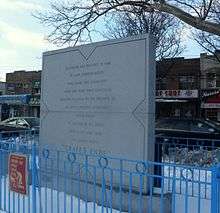Deborah Moody

Deborah, Lady Moody (born Deborah Dunch) (1586–1659?) was the only woman to start a village in colonial America; she was the first female landowner in the New World.[1] She had an unusual influence in a society dominated by men, and was described by contemporaries as "a dangerous woman."
Biography
Deborah was born in London in 1586, the daughter of Walter Dunch of Avebury Manor in Wiltshire and his wife, Deborah, the daughter of James Pilkington, Bishop of Durham. Walter's father was Sir William Dunch, the Auditor of the Royal Mint. Deborah married Sir Henry Moody, 1st Baronet, a marriage that enabled her to be called by the title of Lady. She became a widow by 1629.[2]
Lady Moody left England in 1639 due to religious persecution having adopted Anabaptist beliefs.[3] Deborah, at the age of 54, settled in the town of Saugus, Massachusetts. She then moved to a large farm in Swampscott, just outside of Salem. She corresponded with other religious nonconformists in the area, attracting negative attention from her closest neighbor, Reverend Hugh Peter. Hugh believed in religious unity in the Massachusetts colony. Hugh had already expelled Anne Hutchinson, another Anabaptist woman, two years prior to Deborah’s arrival. In 1643, Deborah was put on trial for spreading religious dissent. Puritan leader John Endecott described her as a "dangerous woman", during her trial. The Church told her to change her beliefs or be excommunicated. Deborah chose excommunication. She gathered her fellow Anabaptists, and set out once again to find a place where they could peacefully practice their religion.
Also in 1643, Director Willem Kieft of the Dutch West India Company was looking for new settlers to add to the population in New Netherland, because he had recently started a war with the local native tribes and wanted more settlers to defend the newly seized land. Deborah had money and followers, and accepted the opportunity to create a new community.
Since the Netherlands and their colonies upheld policies of relative religious tolerance, Deborah's Anabaptist beliefs presented less of a problem. The Dutch West India Company entrusted Deborah with the southwestern tip of Long Island. This includes the areas now known as parts of Bensonhurst, Coney Island, Brighton Beach, and Sheepshead Bay.
Moody named her new community Gravesend. Gravesend was the first New World settlement founded by a woman. Moody allowed total religious freedom in Gravesend, as long as it fell within the laws of the colony.
As Gravesend prospered, Moody gained influence in the government of New Netherland. Upon his arrival in 1647, Moody was among the few to greet the new Director-General Peter Stuyvesant. Stuyvesant called on her to mediate a tax dispute in 1654. And in 1655, she was called upon to nominate magistrates for Gravesend. Deborah lived in Gravesend until her death in 1659.[4]
Today, the area is part of Brooklyn in New York City with the original town square still evident in the street layout.
In 2014, Moody was recognized for her work founding the town of Gravesend in a winning site of Built by Women New York City,[5] a competition launched by the Beverly Willis Architecture Foundation during the fall of 2014 to identify outstanding and diverse sites and spaces designed, engineered and built by women.
References
- ↑ Waisman, Charlotte S.; Jill S. Tietjen (2008). Her Story. Collins. p. 17. ISBN 978-0-06-124651-7.
- ↑ Cooper, A Dangerous Woman: New York's First Lady Liberty, Heritage Books, 1995.
- ↑ "Lady Deborah Moody". National Society of The Colonial Dames of America.
- ↑ Schettino, Allyson (2017). New World, New Netherland, New York (PDF). New York: New York Historical Society. pp. 40–41. Retrieved July 31, 2018.
- ↑ "Beverly Willis Architecture Foundation Hosts Leadership Awards Gala, Kicks off Built By Dinosaurs Exhibition". Architectural Record. Retrieved March 8, 2015.
Further reading
- Biemer, Linda Briggs. Women and Property in Colonial New York: The Transition from Dutch to English Law, 1643–1727 (Ann Arbor: UMI, 1983). xiii+ 155 pp.
- Campanella, Thomas J. "Sanctuary in the wilderness: Deborah Moody and the town plan for colonial Gravesend." Landscape journal 12#2 (1993): 107-130.
- Cooper, Victor H. A Dangerous Woman: New York's First Lady Liberty; The Life and Times of Lady Deborah Moody; Her Search for Freedom of Religion in Colonial America (Bowie, MD: Heritage Books, 1995)